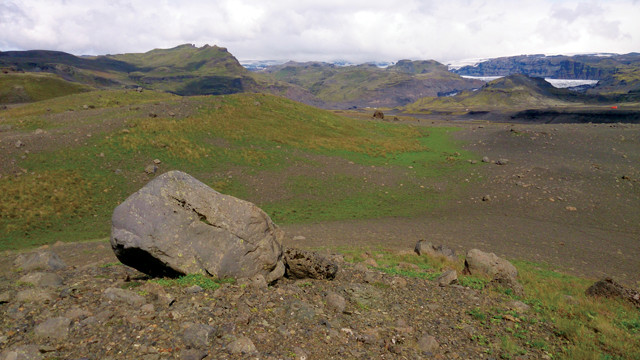
by Mary Caperton Morton Monday, June 19, 2017

Researchers studied flood-displaced boulders like this one in front of the Sólheimajökull Glacier, which overlies Iceland's Katla Volcano, to develop a new tool for dating past flood events. Credit: Thomas Berndt.
In Iceland, volcanoes buried under glaciers occasionally melt huge quantities of ice, setting off massive glacial floods called jökulhlaups. Dating past jökulhlaups helps geologists better understand the eruptive history of Iceland’s many active volcanoes, which, in turn, sheds light on future volcanic hazards. But such dating is no easy task. A new study of magnetic minerals preserved in large boulders moved by floodwaters might provide a new tool in the effort.
“Dating flood events is tricky,” says Thomas Berndt, a geologist at Imperial College London (ICL) and lead author of the new study, published in Geology. “All of the available methods are lacking in some way,” Berndt says. For instance, radiocarbon dating requires finding organic material within a flood deposit, and tephra dating requires the presence of interspersed layers of volcanic ash. The new work “is one of the few attempts to try something fundamentally different from radiometric dating. This method might work in cases where traditional methods don’t,” he says.
Berndt and his ICL colleague, Adrian Muxworthy, went to two locations in Iceland where glacial floods are known from historical accounts to have occurred in the last few hundred years. At Katla Volcano, the Solheimajökull Glacier set off a flood about 155 years ago, and at Kotarjökull, which is part of Vatnajökull Volcano, an eruption unleashed a flood 288 years ago. At both locations, the researchers located large boulders more than a meter across that had been moved by the flood but were too large to have been moved by smaller flood events since.
“When these rocks formed, magnetic inclusions in the rocks were magnetized in the direction of Earth’s magnetic field [at that time]. Like a compass needle, all the magnetic grains pointed north,” Berndt says. But when the rocks were transported by the flood, they tumbled and rotated so that the grains no longer pointed north. “As time passes, some of these grains get remagnetized and start pointing northward again,” Berndt explains. By comparing the proportions of remagnetized to non-remagnetized grains in samples taken from the boulders, Berndt and Muxworthy estimated the amount of time that had passed since the floods. They estimated that the Solheimajökull flood occurred 72 years ago, less than half the actual amount of time that has passed; their estimated age of 290 years for the Kotarjökull flood, however, was just two years off the flood’s actual timing.
“At the moment the technique is really only able to tell us if an event is of the order of tens, hundreds or thousands of years [old] or older,” Berndt says. But radiometric dating presented similar uncertainties when it was first discovered more than a century ago. “Since then a significant effort has been put into refining the instruments [for radiometric dating] and developing a multitude of calibration curves for all kinds of external influences,” he says. “I am positive that if a similar effort were put into magnetic dating, the accuracy should get much better, too.”
Previous studies have attempted to use this method — called viscous remanent magnetization (VRM) — with little success, usually assuming that “remagnetization occurs at a certain steady rate,” Berndt says. But he and Muxworthy improved it, he says, by better delineating factors, like mineral grain size and temperature, that influence how long it takes for minerals to remagnetize. For example, they developed time-versus-temperature curves based on lab studies to understand how remagnetization progresses as a function of temperature.
The new method will not replace other dating methods for floods, but may offer an alternative method to confirm dates produced using traditional methods, says Edwin Baynes, a geomorphologist at the University of Rennes in France who was not involved in the new study. “This new method is interesting because it doesn’t rely on finding organic material for radiocarbon dating, or volcanic layers for tephra dating or the specific types of minerals needed for cosmogenic nuclide dating,” Baynes says. “Each of these methods has its own quirks and drawbacks, so a combination of different methods is often needed to produce reliable dates for flood events.”
Berndt says he next plans to try the VRM method at other glacial flood sites in Iceland, as well as elsewhere to date boulders moved by storm flooding or tsunamis. The catch is that the boulders tested must contain magnetic grains, he notes. “Ideally, you want basalts and other types of igneous rocks. Many sedimentary rocks are not strongly magnetic enough for this kind of study.”
© 2008-2021. All rights reserved. Any copying, redistribution or retransmission of any of the contents of this service without the expressed written permission of the American Geosciences Institute is expressly prohibited. Click here for all copyright requests.